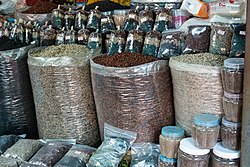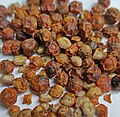Kampot pepper
| Kampot pepper | |
|---|---|
 Kampot pepper plants | |
| Genus | Piper |
| Species | P. nigrum |
| Cultivar | Kampot pepper |
| Origin | pre-13th century |
Kampot pepper (Khmer: ម្រេចកំពត, mrech Kampot; French: poivre de Kampot) is a cultivar of black pepper (Piper nigrum) grown and produced in Cambodia. During the early 20th century under the French protectorate within French Indochina it was also known as Indochinese pepper (French: poivre d'Indochine; Khmer: ម្រេចឥណ្ឌូចិន, mrech Indauchen).[1] The pepper's modern name is derived from the area where it is grown, the Province of Kampot, but its historic name uses the French term for Mainland Southeast Asia.
Kampot pepper is a certified geographical indication (GI) product in Cambodia (since 2010) and in European Union (since 2016).[2] There are two varieties: the small leaf (កំចាយ, kamchay) and the big leaf variety (lampong or belantoeung).[3]
Production
[edit]

Kampot pepper is grown, produced and sold in green, black, white and red varieties, all from the same plant.[4] The climate of Kampot Province offers perfect conditions for growing pepper and the quartz content of the soil in the foothills of the Elephant Mountains helps to give Kampot pepper its unique terroir.[5][6]
The growing conditions are only one of several elements of importance to the production of Kampot pepper. Knowledge of pepper cultivation and production has been handed down from generation to generation in Kampot Province since at least the 13th century. Storage conditions are also of importance and different qualities of Kampot pepper are produced and sold.[6]
Plantations are inspected by the Kampot Pepper Producers Association (KPPA) and by the independent certification body Eco-Cert. Only accredited members of the KPPA, adhering to the PGI criteria, are authorised to sell pepper using the “Kampot Pepper” appellation of origin.
In 2016, at the end of May, Cambodia had produced a total of 11,819 tonnes of black pepper, an increase of 20% compared to the same period of 2015. About 72% of that came from Tbong Khmum, which has over 2,762 hectares of pepper farmland. Comparably, Vietnam tops the list of pepper growing nations with a total crop of 155,000 tons in 2014; a 38.6% share of the global production.[7]
The world market price for pepper is currently favourable and many new pepper plantations are constructed across the country. In some regions, large pepper plantations are contributing to the already alarming deforestation in Cambodia.[7]
Geographical area
[edit]Kampot pepper is grown in seven districts/cities in two southwestern provinces of Cambodia.[3]
History
[edit]Kampot pepper cultivation has a long history and was first described in the 13th century, during the Angkorian era, when the Chinese diplomat Zhou Daguan visited the area.[8] Modern intensive production was initiated under the French colonial rule in the 1870s and at the beginning of the 20th century, Cambodia harvested around 8,000 tons of Kampot pepper annually. In the 1960s, there were still 1 million pepper poles in Kampot, producing around 3,000[9] tons per year, but the production was severely affected by the Cambodian civil war and only 4 tons per year were harvested by the end of the 1990s.[6]
Kampot pepper production slowly gained momentum in the 2000s when previous pepper farmers gradually returned to their lands.[10] As of July 2015, six districts in the southern province of Kampot have pepper farms, while the spice's overseas market consists mostly of Europe, the United States, Japan, Korea, and Taiwan.[11] As the first Cambodian product, Kampot pepper obtained the World Trade Organization's Geographical Indication (GI) status in 2010, tying the quality of the product to its origin.[5] International demand for the product has risen since then. However, annual export volume is still relatively small, i.e. 58 tonnes was produced on 25 hectares for the year 2014.[12] In 2020, the total production of Kampot pepper had reached around 80 tonnes.[13]
Use
[edit]Ground black pepper or green peppercorns are used for the signature Kampot Pepper Crab, where they are stir-fried in sweetened soy sauce with garlic and crab meat.[14] An alternative recipe features green peppercorns stir-fried with squid and garlic in a mix of palm sugar, oyster sauce and fish sauce.[15] Samai Distillery in Phnom Penh uses red Kampot pepper from La Plantation in its Kampot Pepper Rum.[16] To'ak Chocolate makes Kampot Pepper Aged Signature Dark Chocolate from the Nacional cocoa beans and red Kampot pepper.[17]
-
Kampot Pepper Crab featuring green Kampot peppercorns, garlic and spring onion.
-
Cambodian prawns with green Kampot peppercorns.
-
Kampot Pepper Rum spiced with red Kampot pepper (right) produced by Samai Distillery.
-
Dried red Kampot peppercorns.
References
[edit]- ^ Sullivan, Michael (March 14, 2020). "Cambodia's Prized Kampot Pepper, Nearly Wiped Out By Khmer Rouge, Makes A Comeback". National Public Radio. Retrieved 15 March 2020.
- ^ Sopheng, Cheang (2 March 2016). "Cambodia's Kampot pepper wins coveted EU protection". Associated Press. Retrieved 16 November 2016.
- ^ a b "Product specification of the protected geographical indication: Kampot pepper" (PDF). Cambodian Ministry of Commerce. 2015. Retrieved 15 March 2020.
- ^ "Kampot Pepper Cambodia". kampotpepper.biz. KPPA. Retrieved 16 November 2016.
- ^ a b Meredith Bethune (April 2014). "How the World's Best Pepper is Grown in Kampot, Cambodia". Serious Eats. Retrieved 16 November 2016.
- ^ a b c "Kampot Pepper". Farmlink. Retrieved 16 November 2016.
- ^ a b Mech Dara, Igor Kossov (14 June 2016). "Pepper business adds to Kingdom's deforestation woes". The Phnom Penh Post. Retrieved 16 November 2016.
- ^ George Edgar (1 November 2016). "Reaping what you sow". The Phnom Penh Post. Retrieved 16 November 2016.
- ^ Him, Anna (2014). "Kampot Pepper Promotion Association" (PDF).
- ^ Vong Sokheng (11 April 2003). "Daily grind for pepper paupers". The Phnom Penh Post. Retrieved 16 November 2016.
- ^ Sok Chan (8 July 2015). "High 2015 yields for pepper growers". The Phnom Penh Post. Retrieved 16 November 2016.
- ^ Cheng Sokhorng (13 November 2015). "Kampot pepper defying drought fears". The Phnom Penh Post. Retrieved 16 November 2016.
- ^ Chan, Sok (5 January 2021). "Ministry shares 2020 agri-export numbers". Khmer Times. Retrieved 7 January 2021.
- ^ Rivière, Joannès; De Bourgknecht, Dominique; Lallemand, David; Smend, Maja (2008). Cambodian Cooking: A humanitarian project in collaboration with Act for Cambodia. Periplus Editions. p. 71. ISBN 978-0-794-65039-1.
- ^ Dunston, Lara (18 August 2020). "Squid with Green Peppercorns Recipe for Cambodia's Famous Stir-Fry". Grantourismo Travels. Retrieved 10 January 2021.
- ^ Sihan Lee. "Samai: A Tale of Cambodian Spirit". High Net Worth. Retrieved 10 January 2021.
- ^ Godbold, Paul (29 November 2022). "How To'ak Makes The World's Best Chocolate And Revived A Natural Wonder". Luxurious magazine. Retrieved 20 February 2023.




